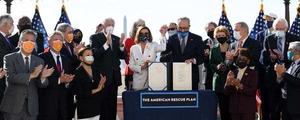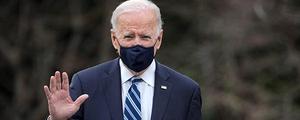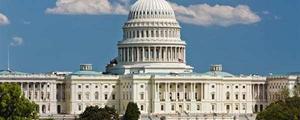Story Highlights
- Democrats led Republicans by nine points in party ID and leaning in Q1
- Largest advantage in a quarter since the fourth quarter of 2012
- Republican Party ID down to 25% as independent identification surges
WASHINGTON, D.C. -- In Gallup polling throughout the first quarter of 2021, an average of 49% of U.S. adults identified with the Democratic Party or said they are independents who lean toward the Democratic Party. That compares with 40% who identified as Republicans or Republican leaners. The nine-percentage-point Democratic advantage is the largest Gallup has measured since the fourth quarter of 2012. In recent years, Democratic advantages have typically been between four and six percentage points.

Line graph. Trend in U.S. adults' party identification and leaning since 1991. Democrats have held an advantage in party identification and leaning for most of the past 30 years, with larger advantages in 1992 and 1993, the mid-to-late 1990s, and from 2006 through 2009.
Gallup routinely measures U.S. adults' party identification and the political leanings of independents. In the first quarter, 30% of Americans identified as Democrats and 19% were Democratic-leaning independents, while 25% were Republican identifiers and 15% Republican-leaning independents. The vast majority of the remaining 11% were independents with no partisan leanings.
The latest figures were measured as President Joe Biden was inaugurated despite rioters' attempts on Jan. 6 to disrupt the certification of his victory in the 2020 election. The first quarter also saw a steady decline in U.S. coronavirus deaths and infections from its early January peak, a great expansion of COVID-19 vaccinations, and the passage of a $1.9 trillion COVID-19 relief package.
Democrats have had larger advantages in the past than they currently hold, including double-digit advantages throughout most of 2006 through early 2009. That period encompassed the end of the George W. Bush administration, when he was unpopular, and the election of Barack Obama as his successor. The party also had double-digit advantages around the time of Bill Clinton's election as president in late 1992 and early 1993. The prior nine-point Democratic edge in the fourth quarter of 2012 coincided with Obama's reelection.
Republican advantages have generally been rare and short-lived, but occurred when Americans rallied around incumbent Republican presidents George H.W. Bush after the 1991 U.S. victory in the Gulf War and George W. Bush after the Sept. 11, 2001, terrorist attacks. The GOP also had brief leads in party affiliation in the periods surrounding Republican electoral successes in the 1994, 2010 and 2014 midterm elections.
Independent Identification Back Up; GOP Identification Down
The 44% of Americans who identify as political independents, whether they subsequently express a party leaning or not, is up from 38% in the fourth quarter of 2020 and is above 40% for the first time since 2019. This is consistent with the historical pattern whereby independent identification typically declines in presidential election years and increases in odd-numbered years.
However, the percentages identifying as independent in 2020 and thus far in 2021 have been unusually high compared with prior presidential election and odd-numbered years. Thus, the current level of independent identification ranks among the highest Gallup has measured in any quarter since 1988, with the high being 46% in the fourth quarter of 2013.
Increased independent identification has mostly come at the expense of the Republican Party, with the 25% of U.S. adults currently identifying as Republicans down from 29% in the fourth quarter. Republican Party identification has not been lower since early 2018 and is just a few points above the low of 22% in the Gallup telephone polling era, registered in the fourth quarter of 2013. During that quarter, GOP favorability sank to a record low during a federal government shutdown over disputes about the Affordable Care Act.
Democratic Party identification is also down, by one point from the fourth quarter, to 30%. It has hovered around that level for most of the past eight years.

Line graph. Trend in Americans' party identification since 1988. The 44% of Americans identifying as political independents in the first quarter of 2021 is among the highest Gallup has measured since 1988.
Bottom Line
It is not unprecedented for Democratic Party affiliation to rise after a Democratic candidate wins the presidential election. It is also not unprecedented to see more people shift to independent political status in a nonelection year, as has occurred. With more of the gain in independent identification coming from the Republican side of the ledger, the GOP is facing its smallest share of Republican identifiers since 2018 and its largest deficit to Democrats on party identification and leaning in nearly nine years.
Republicans did recover from their 2012-2013 deficits to make gains in the 2014 midterm elections and are hoping to duplicate that feat in 2022. Like in 2014, their hopes may rest largely on the popularity level of the incumbent Democratic president.
The GOP's hopes of regaining control of the House and Senate it lost in the past two federal election cycles may also depend on how well the party appeals to independent voters, the largest bloc in the U.S., something the Republican Party struggled to do during the Trump administration.
Learn more about how the Gallup Poll Social Series works.




